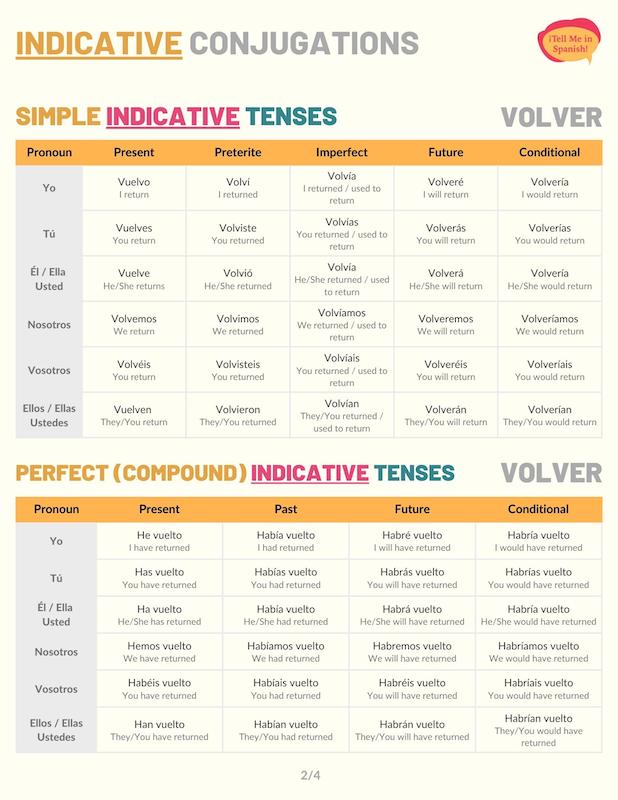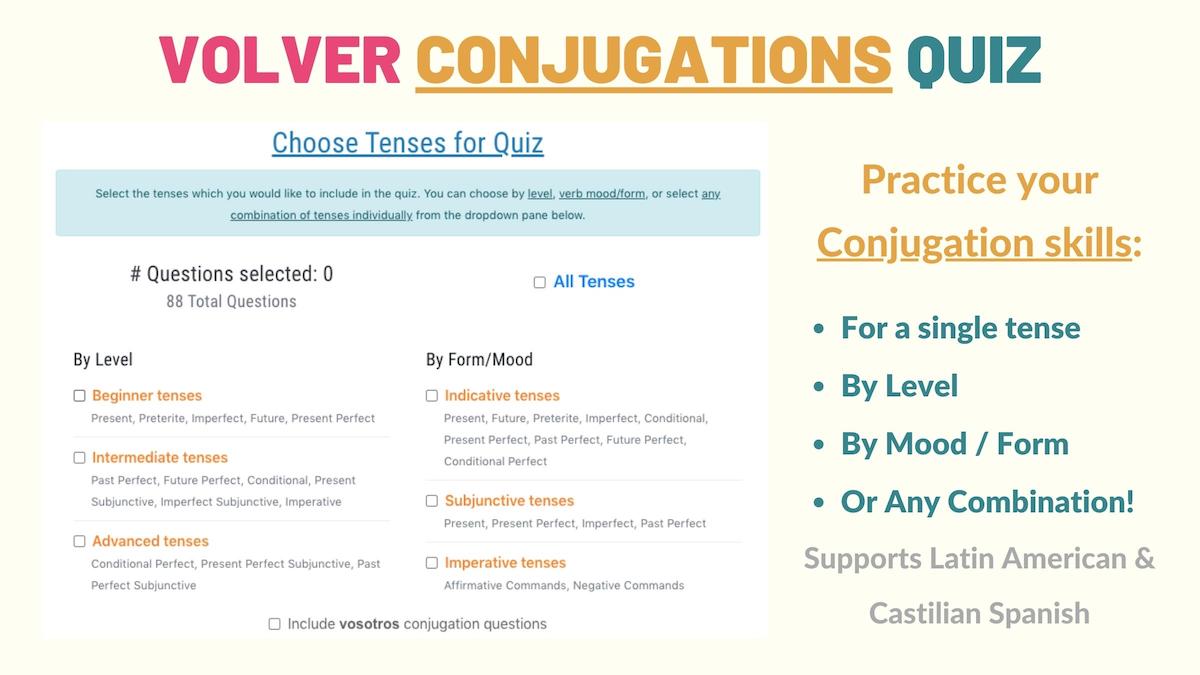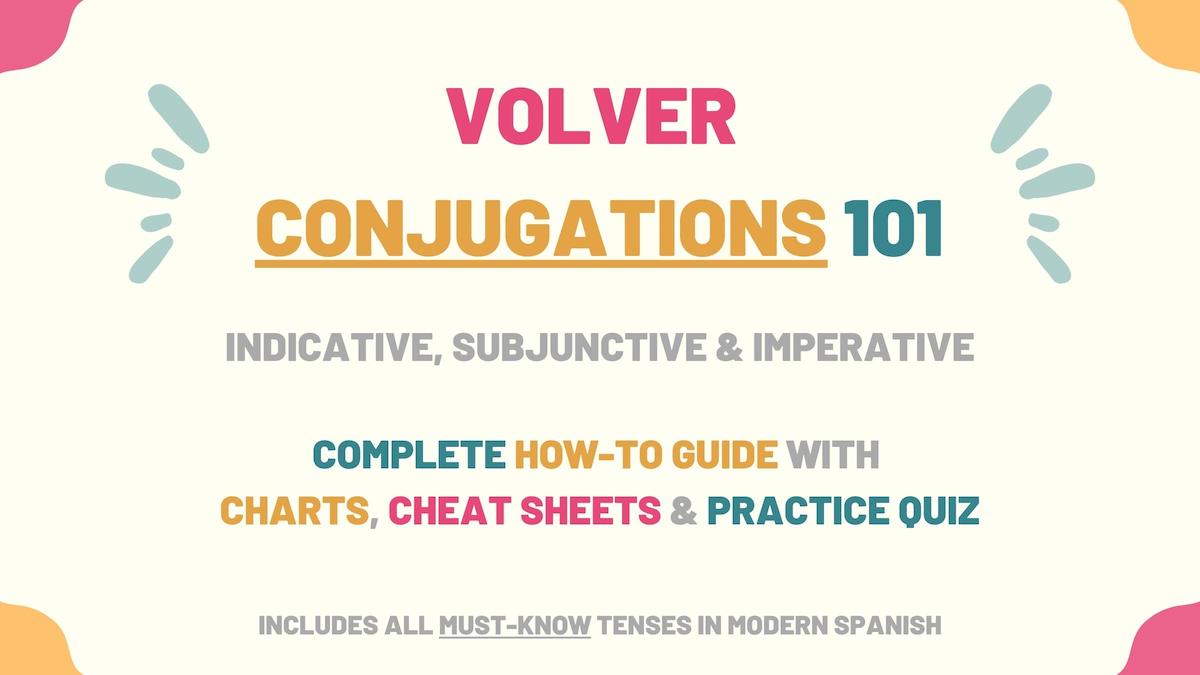Volver is an -ER verb with an O to UE stem change. Since this verb is key for your communication, in this guide, we’ll check volver conjugation patterns. Here is an overview of what you’ll learn:
- Volver Overview
- Indicative Tenses of Volver Conjugations
- Subjunctive Tenses of Volver Conjugations
- Imperative (Commands) of Volver Conjugations
- Uses & Examples
- Download Volver Conjugation Tables & Uses Cheat sheets
- Volver Conjugation Practice Quiz
Overview of Volver
| Verb Characteristic | Property |
|---|---|
| Verb Type | -ER |
| Irregular | No |
| Infinitive | Volver |
| Gerund (Present Participle) Form | Volviendo |
| Past Participle Form | Vuelto |
| Synonyms | Regresar, convertirse, repetir. |
Stem Changes: O to UE
- Present Indicative: vuelv for all subjects except ‘nosotros’ and ‘vosotros’.
- Present Subjunctive: vuelv for all subjects except ‘nosotros’ and ‘vosotros’.
- Affirmative Imperative: vuelv for all subjects except ‘vosotros’.
- Negative Imperative: vuelv for all subject pronouns except ‘vosotros’.
The verb volver in Spanish means ‘to return’, ‘to come back’, ‘to do again’, among other things. However, the conjugation charts below only have one translation to keep the tables as clear as possible. You can learn more about the meanings of ‘volver’ in the section Uses & Meanings.
Indicative Conjugations of Volver
Present tense
Volver conjugations in the present have an O to UE stem change except for ‘nosotros’ and ‘vosotros’. Use the present indicative tense of volver to explain when a person returns from a certain place. For example: Mis papás vuelven mañana.
| Person | Conjugation | Translation |
|---|---|---|
| Yo | Vuelvo | I return |
| Tú | Vuelves | You return |
| Él / Ella Usted | Vuelve | He/She returns You (formal) return |
| Nosotros | Volvemos | We return |
| Vosotros | Volvéis | You return |
| Ellos / Ellas Ustedes | Vuelven | They return You (plural) return |
Preterite tense
As shown in the volver preterite conjugation chart below, this verb has no stem changes in the preterite tense. Conjugate this verb to the Spanish past preterite to communicate that someone returned at a specific moment in the past. You can also use these conjugations to express that a person did something again.
For instance: Ayer, volví a hablar con Jessica.
| Person | Conjugation | Translation |
|---|---|---|
| Yo | Volví | I returned |
| Tú | Volviste | You returned |
| Él / Ella Usted | Volvió | He/She returned You (formal) returned |
| Nosotros | Volvimos | We returned |
| Vosotros | Volvisteis | You returned |
| Ellos / Ellas Ustedes | Volvieron | They returned You (plural) returned |
Imperfect tense
When conjugated to the Spanish past imperfect, this verb is used to describe how or when a person used to come back for an extended period of time in the past. For instance: Nunca volvíamos tarde.
| Person | Conjugation | Translation |
|---|---|---|
| Yo | Volvía | I returned I used to return |
| Tú | Volvías | You returned You used to return |
| Él / Ella Usted | Volvía | He/She returned He/She used to return You (formal) returned You (formal) used to return |
| Nosotros | Volvíamos | We returned We used to return |
| Vosotros | Volvíais | You returned You used to return |
| Ellos / Ellas Ustedes | Volvían | They returned They used to return You (plural) returned You (plural) used to return |
Near future
The immediate future in Spanish is formed by conjugating ir to the present tense + volver. When conjugated to the near future, this verb communicates that someone will return somewhere soon in the future. No te preocupes, vamos a volver muy pronto.
| Person | Conjugation | Translation |
|---|---|---|
| Yo | Voy a volver | I’m going to return |
| Tú | Vas a volver | You’re going to return |
| Él / Ella Usted | Va a volver | He/She is going to return You (formal) are going to return |
| Nosotros | Vamos a volver | We’re going to return |
| Vosotros | Vais a volver | You’re going to return |
| Ellos / Ellas Ustedes | Van a volver | They’re going to return You (plural) are going to return |
Future simple tense
In the future simple tense, volver conveys that someone will return or do something again at some point in the future. For instance: Mañana, volveremos a hablar de este tema.
| Person | Conjugation | Translation |
|---|---|---|
| Yo | Volveré | I will return |
| Tú | Volverás | You will return |
| Él / Ella Usted | Volverá | He/She will return You (formal) will return |
| Nosotros | Volveremos | We will return |
| Vosotros | Volveréis | You (formal) will return |
| Ellos / Ellas Ustedes | Volverán | They will return You (plural) will return |
Conditional tense
Conjugate this verb to the conditional tense in Spanish to communicate that a person would return somewhere. You can also use these volver conjugations to ask a person politely if they would come back to a place. For example: Si pudieras, ¿volverías a tu ciudad?
| Person | Conjugation | Translation |
|---|---|---|
| Yo | Volvería | I would return |
| Tú | Volverías | You would return |
| Él / Ella Usted | Volvería | He/She would return You (formal) would return |
| Nosotros | Volveríamos | We would return |
| Vosotros | Volveríais | You would return |
| Ellos / Ellas Ustedes | Volverían | They would return You (plural) would return |
Present perfect tense
Haber in the present tense + vuelto (past participle) is the formula to conjugate to the present perfect tense in Spanish. Conjugate volver to this tense to express that a person has or hasn’t returned or repeated something. For instance: No he vuelto a verla.
| Person | Conjugation | Translation |
|---|---|---|
| Yo | He vuelto | I have returned |
| Tú | Has vuelto | You have returned |
| Él / Ella Usted | Ha vuelto | He/She has returned You (formal) have returned |
| Nosotros | Hemos vuelto | We have returned |
| Vosotros | Habéis vuelto | You have returned |
| Ellos / Ellas Ustedes | Han vuelto | They have returned You (plural) have returned |
Past perfect
Volver in the Spanish past perfect form expresses that someone had returned somewhere before another past action or time frame. For example: No había vuelto a mi casa desde Navidad.
| Person | Conjugation | Translation |
|---|---|---|
| Yo | Había vuelto | I had returned |
| Tú | Habías vuelto | You had returned |
| Él / Ella Usted | Había vuelto | He/She had returned You (formal) had returned |
| Nosotros | Habíamos vuelto | We had returned |
| Vosotros | Habíais vuelto | You had returned |
| Ellos / Ellas Ustedes | Habían vuelto | They had returned You (plural) had returned |
Future perfect
In Spanish, the future perfect conjugations of haber convey that someone will have returned or done something again by or before a certain moment in the future. For example: Habremos vuelto antes de que te des cuenta.
| Person | Conjugation | Translation |
|---|---|---|
| Yo | Habré vuelto | I will have returned |
| Tú | Habrás vuelto | You will have returned |
| Él / Ella Usted | Habrá vuelto | He/She will have returned You (formal) will have returned |
| Nosotros | Habremos vuelto | We will have returned |
| Vosotros | Habréis vuelto | You will have returned |
| Ellos / Ellas Ustedes | Habrán vuelto | They will have returned You (plural) will have returned |
Conditional perfect
Conjugate volver to the conditional perfect tense to express that someone would have returned if a past action had been performed. For example: No habríamos vuelto, si no nos hubieras hablado.
| Person | Conjugation | Translation |
|---|---|---|
| Yo | Habría vuelto | I would have returned |
| Tú | Habrías vuelto | You would have returned |
| Él / Ella Usted | Habría vuelto | He/She would have returned You (formal) would have returned |
| Nosotros | Habríamos vuelto | We would have returned |
| Vosotros | Habríais vuelto | You would have returned |
| Ellos / Ellas Ustedes | Habrían vuelto | They would have returned You (plural) would have returned |
Progressive tenses
Conjugate estar + present participle (volviendo, in this case) is the formula to form volver’s progressive tenses. Use these conjugations to explain that someone is returning somewhere at the moment of speaking. You can also use these forms to say that someone is currently repeating an activity.
For example: Mi papá está volviendo a pintar la sala.
| Progressive Tense | Formula | Translation Example |
|---|---|---|
| Present | Estar (present) + volviendo | I am returning |
| Preterite | Estar (preterite) + volviendo | You were returning |
| Imperfect | Estar (imperfect) + volviendo | He was returning |
| Future | Estar (future) + volviendo | We will be returning |
| Conditional | Estar (conditional) + volviendo | They would be returning |
Volver Subjunctive Conjugations
To refer to wishes, requests, suggestions, expectations, doubts, or hypothetical situations, you must use the Spanish subjunctive mood. In the sections below, you’ll find the volver conjugation charts for the subjunctive tenses we currently use in Spanish.
Present subjunctive
Volver subjunctive conjugations have an O to UE stem change for all subjects except ‘nosotros’ and ‘vosotros’. The present subjunctive conjugations of ‘volver’ are used to hope, request, or suggest someone to return to a place. For instance: Quiero que vuelvan temprano.
| Person | Conjugation | Translation |
|---|---|---|
| Yo | Vuelva | I return |
| Tú | Vuelvas | You return |
| Él / Ella Usted | Vuelva | He/She returns You (formal) return |
| Nosotros | Volvamos | We return |
| Vosotros | Volváis | You return |
| Ellos / Ellas Ustedes | Vuelvan | They return You (plural) return |
Present perfect subjunctive
The present subjunctive forms of haber + vuelto (past participle form in Spanish) is the structure we use to conjugate volver to the present perfect subjunctive. These conjugations allow you to wish or express doubt about whether a person has already returned.
For instance: ¿Crees que Lucía y Luis ya hayan vuelto de su viaje?
| Person | Conjugation | Translation |
|---|---|---|
| Yo | Haya vuelto | I have returned |
| Tú | Hayas vuelto | You have returned |
| Él / Ella Usted | Haya vuelto | He/She has returned You (formal) have returned |
| Nosotros | Hayamos vuelto | We have returned |
| Vosotros | Hayáis vuelto | You have returned |
| Ellos / Ellas Ustedes | Hayan vuelto | They have returned You (plural) have returned |
Imperfect subjunctive
The Spanish imperfect subjunctive tense refers to past suggestions, requests, and wishes someone had about a person coming back or redoing an activity. Te pedí que volvieras a hacer el pastel.
Based on the type of Spanish you use, the imperfect subjunctive tense has two conjugation models:
Latin American Spanish version
| Person | Conjugation | Translation |
|---|---|---|
| Yo | Volviera | I returned |
| Tú | Volvieras | You returned |
| Él / Ella Usted | Volviera | He/She returned You (formal) returned |
| Nosotros | Volviéramos | We returned |
| Ellos / Ellas Ustedes | Volvieran | They returned You (plural) returned |
Note: The conjugation chart above doesn’t include the volver conjugation for vosotros since this pronoun is not used in Latin American Spanish.
Castilian Spanish version
| Person | Conjugation | Translation |
|---|---|---|
| Yo | Volviese | I returned |
| Tú | Volvieses | You returned |
| Él / Ella Usted | Volviese | He/She returned You (formal) returned |
| Nosotros | Volviésemos | We returned |
| Vosotros | Volvieseis | You returned |
| Ellos / Ellas Ustedes | Volviesen | They returned You (plural) returned |
Past perfect subjunctive
Use volver conjugated to the Spanish past perfect subjunctive to express that someone would have returned somewhere if a past circumstance had taken place. These forms also express regret for returning or not returning to a place.
For example: Si hubiera podido, hubiera vuelto antes.
| Person | Conjugation | Translation |
|---|---|---|
| Yo | Hubiera vuelto | I had returned |
| Tú | Hubieras vuelto | You had returned |
| Él / Ella Usted | Hubiera vuelto | He/She had returned You (formal) had returned |
| Nosotros | Hubiéramos vuelto | We had returned |
| Vosotros | Hubierais vuelto | You had returned |
| Ellos / Ellas Ustedes | Hubieran vuelto | They had returned You (plural) had returned |
Volver Imperative Conjugations
To command people to do or not do something, you must use Spanish commands or imperatives.
Affirmative commands
Volver’s affirmative imperative conjugations also have an O to UE stem change that doesn’t affect the pronoun ‘vosotros’. Use these affirmative commands to order someone to return at a certain time or place. For example: Ve, pero vuelve en una hora.
| Person | Conjugation | Translation |
|---|---|---|
| Tú | Vuelve | Return |
| Usted | Vuelva | Return |
| Vosotros | Volved | Return |
| Ustedes | Vuelvan | Return |
Negative commands
To order someone not to return, you must use the negative imperative in Spanish. When forming negative commands, volver is an O to UE stem-changing verb for all subject pronouns except for ‘vosotros’. Here is an example: Por favor, váyanse y no vuelvan.
| Person | Conjugation | Translation |
|---|---|---|
| Tú | No vuelvas | Don’t return |
| Usted | No vuelva | Don’t return |
| Vosotros | No volváis | Don’t return |
| Ustedes | No vuelvan | Don’t return |
Meanings of Volver & Examples
Now that you’ve learned how to conjugate volver in Spanish, you should check these examples to see how to use this verb correctly in its various conjugated forms.
- Talking about returning to a place
[Volver conjugated] + [complement]
¿A qué hora vuelve mi papá?
What time does dad return?
Vuelva en una hora, por favor.
Come back in an hour, please.
Take Note: In Spanish, this verb cannot be used to talk about returning products or things you bought. In this case, you must use regresar or devolver. Devolver is formed with the suffix ‘volver’, meaning that it’s conjugated with volver’s conjugation pattern.
- Expressing that someone is doing something again
[Volver conjugated] + a + [infinitive verb]
¿Cuándo van a volver a venir?
When are you guys going to come again?
Estamos volviendo a ver The Office.
We are watching The Office again.
Take Note: Volver a + infinitive is a verb phrase that expresses repetition. The activity you’re repeating is expressed by a verb in the infinitive form.
Download Volver Conjugation Tables & Uses Cheat sheets

Volver is a common verb with stem changes in several tenses. You can download the cheat sheets PDF below which contains all the volver conjugation charts. It also has a short definitions and uses section where you’ll find example sentences for using this verb in real-world daily conversations.
Practice Quiz: Volver Conjugation

Now that you’ve seen how to conjugate volver in Spanish, you can drill yourself on its different regular and stem-changing forms by taking this volver conjugation practice quiz.





